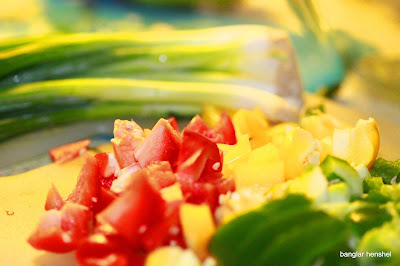There is a sweet story associated with this particular preparation of Tangra fish. My mom being a perfect ghoti (West Bengal) used to make this fish mostly in a mustard sauce gravy or onion-garlic sauce. But during my marriage she hired a cook (mashi) who was bangal (East Bengal Origin) and was generously good at every item she cooked for us. I can still remember the taste of Tangrar marich jhal she cooked. That was the first time I tasted that preparation and was in love with that. We had a sleepless tensed night the day before we had this item. When my marriage was fixed I used to work in Delhi. My mom was in Kolkata. My jijaji (brother-in-law) made a big mistake while booking the tickets for us. Instead of booking the ticket for 2313 Sealdah Rajdhani down (Kolkata bound), in hurry he booked the ticket for 2314 :Sealdah Rajdhani up (Delhi bound). So the day of the journey, me super exited and happy inside, when boarded the train was totally fuzed to discover the seats assigned to us are actually possessed by others. Then with those passenger's help we found that we have booked the wrong ticket. That was a traumatic experience. Only 3 days were left for my marriage and me still in Delhi made me feel totally disheartened. I felt like I won't be able to reach to my wedding function. That time telephonic conversation with my hubby consoled me a lot and helped me build up my confidence. We did not return to our didi's home that night. We have returned those useless tickets and also re-booked the ticket for Kalka Mail next morning with the help of a travel agency. We stayed that night in a hotel in Pahar Ganj, close to the station and boarded the train next morning in time. We reached exactly 24 hours after we were supposed to reach originally. My mom was super tensed at her place as she was only alone managing everything by herself. Me and didi reached just like guests one day before my aiburobhat (feast just before the day of marriage). After the long journey and so much tension, the lunch served to us cooked by masi comprising Tangrar morich jhal was so much inviting and tasty, it boosted high up my spirit and made my smile back again on my face.
Now after all this bakwas (nonsense talk) let me me share the recipe:
Ingredients:
1. 500 grams of Tangra Fish
2. Salt for marinating the fish and also for the gravy as per taste
3. Turmeric: 2 teaspoon
4. Mustard oil: 4 tablespoon
5. 3 teaspoons of Onion seeds/ Nigella seeds/Kalo jeere/Kalunji
6. 2 teaspoons of Cumin seeds/Jeera
7. 10-12 whole black pepper
8. 2 teaspoons of tomato paste
9. Green chillies: 3/4 slit
10. Sugar: 1 teaspoon (optional)
11. Garlic clove 4/5
Steps:
1. As I got the frozen block of fish it took time to defrost the fish. Easy way of defrost is to keep the frozen packet in sink for 3-4 hours. The ice melts by itself and you get fish easily ready for cooking. If you don't have that much time in hand, cut the packet, take the block out of the packet and run hot water over the block for 10 minutes. The fishes will come off the ice easily. Wash the fish and then rub them with salt and turmeric powder and a drizzle of mustard oil. This oil while marinating helps less splutter while frying the fish. I have learned this from Zee Bangla Rannaghor.
2. Heat Mustard oil in a non-stick Kadhai. When you see smoke, reduce the heat and then throw the fishes in the kadhai slowly. Once one side is cooked golden brown, fry other side as well.
3. While you fry the fish, you can make the spice mix ready. In a coffee grinder/dry grinder, grind whole black peppers, cumin seeds and onion seeds together to a fine powder. Add little water to that powder and soak it for some time.
4. Once you have fried all the fishes, if you see there is not adequate oil in the kadhai, add some more (1 tablespoon is enough to cook the gravy). Now add some chopped the garlic cloves. When they turn brown, take them off the oil. The garlic cloves have been added just to make the oil fragrant.
5. Now add the slitted green chilies to the oil. When it starts spluttering, add the tomato paste to the oil and saute it for some time. If you do not have ready made tomato paste, you can also use deseeded, deskinned pureed tomato (1 medium tomato).
6. When oil starts separating add the Black pepper + Cumin + Onion seeds mix to the oil and cook it for some time. You might need to sprinkle a little water to stop the mix to stick to the bottom of the pan.
7. After 3/4 minutes of cooking the masala add 1 cup of water and salt as per taste and just a little sugar to make the gravy. When the gravy starts boiling add the fried fishes into the gravy. Let them get coated by the gravy well. This preparation would be little dry and the gravy would be sticking to the fishes..
8. Your fish is ready now. Serve it hot with white rice.
Enjoy












.JPG)
.JPG)
.JPG)
.JPG)
.JPG)
.JPG)
.JPG)
.JPG)











